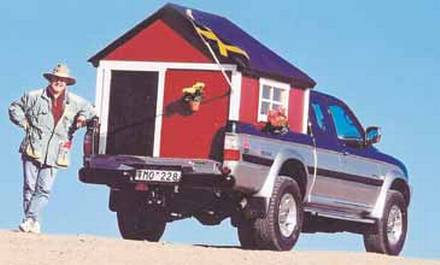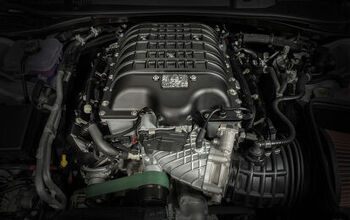Saab Won't Be Saved. Not Even By This Man

The dwindling and demoralized ranks of Saab flagwavers had a bad week. No cash in the kitty, bankruptcy looms, their savior Vladimir Antonov is rebuffed by the European Investment Bank, dirty laundry about funds seeping away to hot islands is being aired. Their hopes now cling to a sheet of paper. Today, Christer Gerlach wrote an op-ed piece in Sweden’s Dagens Nyheter in which he makes the case that Saab should not be written off just yet. He is asking the Swedish government for help . A translation is printed at Saabsunited.
Christer Gerlach is a famous autowriter. The 66 year old Swede became notorious in 1972 by crossing the Sahara in a Citroen 2CV. In 1988, he entered the Guinness Book of World records in a solo trip around the world – in a Toyota Corolla. If you want the impossible on four wheels, Gerlach is the man to call. I would not call him to restructure a moribund car company.
His proposal is based on two assumptions: Small car companies can flourish. Government aid to car companies is normal. So please, Swedish government, help Saab.
Says Gerlach:
“There are several small or medium-sized auto plants that are successful: Mini, Suzuki, Dacia, Rolls Royce, Bentley, Lamborghini, Subaru.”
Bad mistake number one. All of these except one belong to a huge company. And the only exception is neither small nor medium-sized. Mini and Rolls belong to BMW, Dacia to Renault, Bentley and Lamborghini to Volkswagen, Subaru to Fuji Heavy, in partnership with Toyota.
The only independent, Suzuki, is the world’s 9th largest automaker with 2.9 million cars made in 2010. And even Suzuki needed a little help from Volkswagen, to the tune of $2.4 billion.
His list proves just the opposite: There is no room for an independent small or medium-sized automaker in this world.
Gerlach points to the successes of Volvo and JLR:
“When Ford sold Volvo it also sold British Jaguar / Land Rover. Indian mega-firm Tata bought Jaguar / Land Rover, which then together produced about 250,000 cars a year. Far fewer than the Volvo. Jaguar alone produced around 50,000 cars – about half as many as Saab in a “normal” year.”
Again, Gerlach proves the point that Saab is too small to survive. When Ford sold Volvo, Volvo made 336,000 cars per year and lost money hand over fist. When JLR was bought by Tata it had made 261,000 units in 2008. JLR “produced just 167,000 vehicles and recorded $460 million in losses” in the first 10 months after the takeover, writes the Independent in India.
Both brands brought serious volume, know-how, and brand cachet to their buyers. Volvo was bought by Geely which had made 330,000 units in 2009. JLR was bought by Tata which had 537,000 units to its name in 2008.
For Ford, JLR and Volvo were money sinks. For emerging market producers Geely and Tata, the units, bought on the cheap, had strategic value – when combined with existing operations.
Saab made 20,000 cars in 2009 and 32,000 in 2010. In 2011, next to none so far. What volume does it contribute? What know-how? Most of Saab’s IP is owned by GM.
Saab isn’t even big enough to create rapid eye movement at a serious Chinese carmaker. Auto dealer Pang Da and busmaker Youngman are bit players in China.
Lars Holmqvist, head of the European supplier association CLEPA, was one of the few who realize that the emperor has no clothes when he said:
“This is not a matter where a Scrooge McDuck goes in with a lot of money. The basic problem is that Saab does not sell cars. They sold 28,600 cars last year. One cannot survive on that in our industry.”
This industry is all about scale. If you can’t survive on 330,000 Volvos from how much delusion does one need to suffer to think that 30,000 are just divvy? Running a car company is one of the most complex undertakings in this world today. Shooting a rocket into space is child’s play compared to that. This is no place for amateurs or dreamers – unless they are rich amateurs who want to be poor when they wake up.
Lastly, Gerlach makes the case that the U.S. government owned 60 percent of GM, that the German state of Lower Saxony owns 13 percent of Volkswagen, and that France owns 15 percent of Renault. Therefore, says Gerlach:
“A temporary state involvement in the Saab would dramatically increase chances for Saab to survive and increase confidence among foreign investors.”
Gerlach forgets that the Swedish government already is more involved in Saab than it wants. The Swedish government guaranteed the $350 million loaned by the EIB to Saab. To pass EU scrutiny, the loan had to be structured as an investment into research and development of green technologies and safety. It wasn’t meant to pay salaries and suppliers. Sweden buying equity in Saab is not in the cards. The commissars of Brussels would be all over it. What’s more, threatening lawsuits against the government and hoping that they invest shows a certain degree of outerworldly thinking.
Lastly, a state investment into Saab does not make political sense. The sad truth is that “saving jobs” is code for “buying votes.” Sweden does not need any votes at the moment. Trollhättan is no Michigan. The Saab workers are no UAW. 3,500 votes more or less do not change the Swedish political landscape.
The next elections are in 2014. Saab will not be a topic at these elections.

Bertel Schmitt comes back to journalism after taking a 35 year break in advertising and marketing. He ran and owned advertising agencies in Duesseldorf, Germany, and New York City. Volkswagen A.G. was Bertel's most important corporate account. Schmitt's advertising and marketing career touched many corners of the industry with a special focus on automotive products and services. Since 2004, he lives in Japan and China with his wife <a href="http://www.tomokoandbertel.com"> Tomoko </a>. Bertel Schmitt is a founding board member of the <a href="http://www.offshoresuperseries.com"> Offshore Super Series </a>, an American offshore powerboat racing organization. He is co-owner of the racing team Typhoon.
More by Bertel Schmitt
Latest Car Reviews
Read moreLatest Product Reviews
Read moreRecent Comments
- 3SpeedAutomatic 2012 Ford Escape V6 FWD at 147k miles:Just went thru a heavy maintenance cycle: full brake job with rotors and drums, replace top & bottom radiator hoses, radiator flush, transmission flush, replace valve cover gaskets (still leaks oil, but not as bad as before), & fan belt. Also, #4 fuel injector locked up. About $4.5k spread over 19 months. Sole means of transportation, so don't mind spending the money for reliability. Was going to replace prior to the above maintenance cycle, but COVID screwed up the market ( $4k markup over sticker including $400 for nitrogen in the tires), so bit the bullet. Now serious about replacing, but waiting for used and/or new car prices to fall a bit more. Have my eye on a particular SUV. Last I checked, had a $2.5k discount with great interest rate (better than my CU) for financing. Will keep on driving Escape as long as A/C works. 🚗🚗🚗
- Rna65689660 For such a flat surface, why not get smoke tint, Rtint or Rvynil. Starts at $8. I used to use a company called Lamin-x, but I think they are gone. Has held up great.
- Cprescott A cheaper golf cart will not make me more inclined to screw up my life. I can go 500 plus miles on a tank of gas with my 2016 ICE car that is paid off. I get two weeks out of a tank that takes from start to finish less than 10 minutes to refill. At no point with golf cart technology as we know it can they match what my ICE vehicle can do. Hell no. Absolutely never.
- Cprescott People do silly things to their cars.
- Jeff This is a step in the right direction with the Murano gaining a 9 speed automatic. Nissan could go a little further and offer a compact pickup and offer hybrids. VoGhost--Nissan has laid out a new plan to electrify 16 of the 30 vehicles it produces by 2026, with the rest using internal combustion instead. For those of us in North America, the company says it plans to release seven new vehicles in the US and Canada, although it’s not clear how many of those will be some type of EV.Nissan says the US is getting “e-POWER and plug-in hybrid models” — each of those uses a mix of electricity and fuel for power. At the moment, the only all-electric EVs Nissan is producing are the Ariya SUV and the perhaps endangered (or maybe not) Leaf.In 2021, Nissan said it would make 23 electrified vehicles by 2030, and that 15 of those would be fully electric, rather than some form of hybrid vehicle. It’s hard to say if any of this is a step forward from that plan, because yes, 16 is bigger than 15, but Nissan doesn’t explicitly say how many of those 16 are all-battery, or indeed if any of them are. https://www.theverge.com/2024/3/25/24111963/nissan-ev-plan-2026-solid-state-batteries


































Comments
Join the conversation
I was at the Cadillac/Saab dealer today and they had two 2010 SAAB 9-5 Aeros on the showroom floor unsold. Looking at the window sticker revealed why. $54000. The 9-5 Aero is a fine product but the overpriced by at least $10,000. I have always liked SAABs, I hope the brand does not go under but in today's highly competitive car market it takes a very fine product to make it. The SAAB is but they need to lower the price.
Neither Seat nor Skoda are in any way comparable to SAAB. First, they are part of Europes No. 1 car manufacturer with an annual production of millions of cars. They are using platforms, engines and thousands of other parts from VW's vaults. In fact, SEAT is producing and selling the last generation Audi A4 as a SEAT - the EXEO - now - with a few cosmetical changes to interior and exterior design. Synergy rules in the VW empire! Second, neither SEAT nor SKODA are even close to premium manufacturers - even if Skoda has been successfully aiming at the E(xecutive)-segment with its fabulous second generation Superb - which is basically a very well designed, simplified VW Passat produced in Tchechia at much lower costs than in Wolfsburg. Interestingly enough, nobody seems to have a problem with VW's synergy strategies. Whereas SAABs have too often been called "GM-clones" and "OPELs made in Sweden", VW can do exactly what was never true for SAAB - without even the slightest damage to the image of its products.